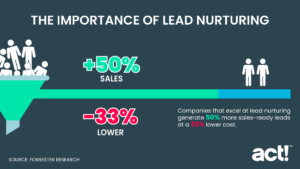
When your marketing wizardry starts paying off and the leads start pouring in, how do you know which leads to pursue with fervour and which ones to ‘nudge gently’ every now and again? Enter lead scoring.
Lead scoring is a grading system that helps you assign numbers to leads, ranking your leads from ‘most likely’ to ‘least likely’ to becoming a paying customer using the information you collect. Categorising or ‘scoring’ your lead data in this way will help you maximise your sales effort so that you can work out which leads need more nurturing, and which ones are better left alone.
Why is lead scoring important?
To illustrate the importance of lead scoring, we might need to revisit Pareto’s Principle. Pareto Principle (also known as the 80/20 rule) states that ‘80% of consequences come from 20% of the causes.’ This means that for a business,
80% of revenue will come from 20% of clients. While the ratio is not cast in stone, this Principle’s been seen to hold true for most spheres of life. Back to lead scoring.
Pareto’s Principle illustrates that 20% of the leads of your business will bring 80% of your revenue. These are likely to be your highest paying customers, repeat customers, people loyal to and ready to spend on your business. To make your marketing efforts count, you need to be able to identify this special group of leads and convert them fast – and this is what lead scoring will help you achieve. One of the other benefits of lead scoring is it saves you time and effort which in turn, saves you money. With lead scoring, you have knowledge of three broad categories of your customers:
1. Those to focus more on
2. Those to nurture
3. Those to leave behind
An efficient lead scoring strategy will turn your sales and marketing team into sharpshooters. They will have insight into the leads, offering them the information required to handle each category from potential big-time clients to visitors. Unfortunately, many businesses do not use lead scoring.

What is lead segmentation?
Lead segmentation is very similar to market segmentation – it is basically segmenting your database of leads into lists, based on categories you define.
Lead segmentation does not just group leads based on common needs, but on similar characteristics, interests, job titles, demographics and more. Segmentation is important for a number of reasons, but ultimately it is the key to laser-targeting your customers based on their differences, as well as based on how they perceive the full value of certain products.
While lead scoring may rank leads, segmentation groups them in a way that it is easier to deploy actionable strategies based on gathered or available information. It is easy to see that lead segmentation goes hand-in-hand with lead scoring, and both may even be used interchangeably in some cases.
Creating a successful lead scoring strategy
It is important to remember that lead scoring isn’t a one-size-fits-all strategy. Marketing efforts could still fail after implementing lead scoring, especially if your strategy is lacking in implementation. Your lead scoring strategy should be personalised to suit the dynamics of your business and marketing/sales team, keeping in mind that wrong implementation could lead to a potential disaster. Imagine implementing a strategy that erroneously places ‘purchase-ready’ leads in the red zone? A competitor with a better lead scoring strategy might scoop up these leads to your disadvantage. This is why the lead scoring process needs constant tweaking until you can determine what works best for your business.
To create a winning lead scoring strategy, here are seven actionable steps which you can start implementing today:
1. Determine the characteristics of your personas and segments
First, seek to understand your leads and then group them into segments. This will involve asking pertinent questions such as:
- Who are my leads?
- What do they want?
- Where are they coming from?
- When do they engage the most?
- Why are they interested?
2. Determine the characteristics of your ideal customer
Your ideal customer is the one who you believe is most likely to make a purchase. This is the customer who will score 4-5 on a five-point scale, and you should be able to identify this customer by gauging their behaviour against certain criteria such as:
Explicit criteria
The information which directly informs you about your leads and their behaviour, such as demographics, purchase history, purchasing power, nature of job etc.
Implicit criteria
This is information that shows the likelihood of getting interest from a lead, and this is usually inferred from client behaviour. This can include social media interactions, website behaviour (time-on-page, clicks, number of visits), number of phone calls, email enquiries, and so on.
Negative criteria
Negative criteria exclude leads based on certain criteria and can help you identify the leads least likely to turn into committed clients. These leads can be identified based on negative criteria such as unsubscriptions from email campaigns, low social media interaction, little website visits or high bounce rates. While negative criteria may look bad, it offers valuable insight into what set of leads is most likely to waste your resources.
3. Create your in-house points system
Once you understand who your best and worst potential leads are, you can assign points to your leads based on a grading system that you determine. In doing this, it is advisable that you stick to a small range of values, as assigning numbers over a wide range may introduce problems down the line – how do you manage a lead graded 49 on a 100 point system?
Usually, a 5-point range (where 5 is most likely to convert and 1 is least likely) tends to work quite well with most marketers. This narrow grading system makes the lead scoring easy to interpret and can be passed to the sales team for easy follow up.
4. Pick a winning team
Pick a dedicated team to handle the creation, implementation and constant iteration of your lead scoring strategy. This team can involve staff from your sales and marketing departments.
5. Design courses of action and assign responsibilities
Each final lead score should come with a set of actions, such as a service level agreement to help to define the best course(s) of action for each lead, based on their lead score. The courses of action which you choose to recommend following lead scoring could be as specific as the number of marketing emails to send to an MQL (marketing-qualified lead) or SQL (sales-qualified lead). You will also need to remember to assign responsibilities to team members for the different lead scores with the actions required. All of this information should be outlined in a document so that each member of your team knows where they fit in.
6. Test the model
Test your model to gauge its efficiency. Start with on a small scale before deploying across the board.
7. Assess and Evaluate
Expect to test your lead scoring strategy multiple times before arriving at the most suitable model. You and your team should review the model often, making adjustments as you progress.
Conclusion
A successful lead scoring strategy has the potential to completely transform your marketing and sales efforts. It will save you time and money as your marketing will be able to targets leads with the highest potential of converting to sales, placing you ahead of your competition.
If you have access to marketing automation tools, it might be best to create your own in-house algorithm for lead scoring. Otherwise, you can adjust any of the available templates online to suit your business.






